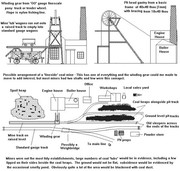Interesting answers from Sandy there, Chops.
Just to add my 2centsworth.
Memories of pits around Glasshoughton Yorkshire, Easington Colliery County Durham and Washington County Tyne & Wear (formerly County Durham).
1930s/40s The area around John H. Rhodes Prince of Wales pits, Glasshoughton was hard compacted slag. Compacted so hard so whenever it rained the water remained on top with nowhere to run. I suppose when dry it could resemble concrete. Cobbles were evident where the railways ran into the pit yards. They were not clean by any standards. What with coal dust getting into every crevice rainfall was on a losing battle. Rainfall did clean the tops of cobbles, but afterwards tiny bits of dust would sparkle like dark blue diamonds. (Coal is not all black

)
The main streets where the mining families lived were hard compacted slag also. The more wealthy families had cobbled streets. The back lanes of houses were soil with ash (from the fires in the houses) covering the walking area
1960s Easington Colliery (Billy Elliot film was filmed here) The whole area was cobbled until the main road through Easington. This road is outside the coal mine area and is covered in tarmac. The street names are easy to remember. First Street. Second Street. Third Street, and so on.

1970s Washington. The pits had closed. Gone went the cobbles, the slag heaps and pit ponds. A new housing estate with the area named after the pits. Blackfell Pit area is Blackfell Village; Glebe Pit area is Glebe Village and so on.
As an aside. Rose Pit close to Rothwell Station (near Leeds Yorkshire) was sunk between 1847 and 1853 and was in production until 1925. After that the shaft was used for ventilation of the Fanny Pit workings. It is believed the buildings were demolished in 1947.
I have to smile at the rather cheery fellow wrestling mineral wagons looking as though he was dressed in his Sunday best, to include a carefully knotted bow tie.

It was common for men to wear some kind of short tie/ scarf; many a day with no shirt. Be they be at a mine or farmer's field.
As for American mineworking watch a film called 'Matewan'.
Hope all this helps.
Glencairn
I forgot. If you model a mine and its workings do not forget a small first aid building. I spent the night in the one at Easington Colliery, (but that is another story.

)
Glencairn
To the world you are someone. To someone you are the world
I Cannot Afford the Luxury of a Negative Thought.




 [/u click on link
[/u click on link